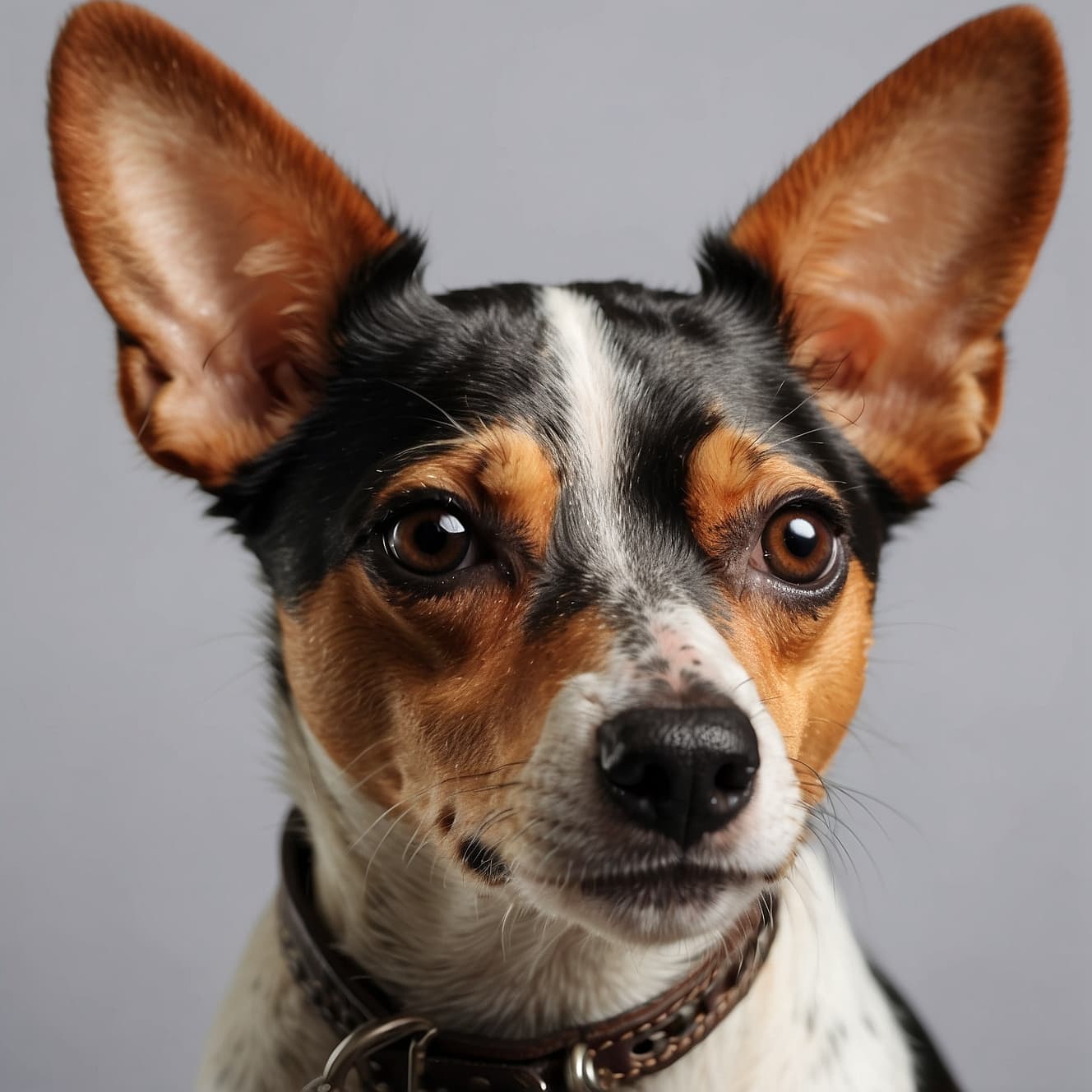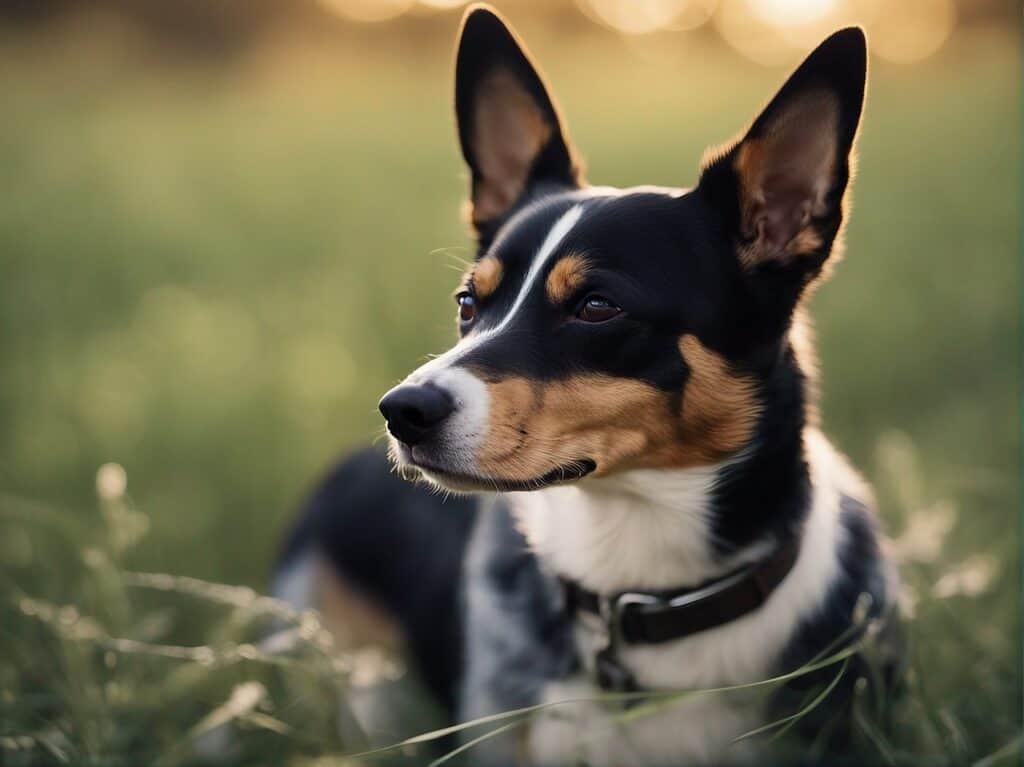Rat Terriers are versatile working dogs with a rich history. Discover their background, understand the care they need, and appreciate the agility and intelligence that make Rat Terriers remarkable in various roles.

| Category (Explanation) | Breed Information |
|---|---|
| Year of Breed Conception | 19th century |
| Country of Origin | United States |
| Weight (lbs & kg) (Male) | 10-25 lbs (4.5-11 kg) |
| Weight (lbs & kg) (Female) | 10-25 lbs (4.5-11 kg) |
| Coat Type | Short, smooth coat |
| Color Variations | Various colors, often with white markings |
| Shedding Level (Low, Moderate, High) | Low to Moderate |
| Height (cm & in) | 10-18 inches (25-46 cm) |
| Breed Size | Small to Medium |
| Trainability (Low, Moderate, High) | High |
| Mental Needs (Low, Moderate, High) | Moderate |
| Intelligence Level (Low, Moderate, High) | High |
| Energy Level (Low, Moderate, High) | High |
| Agility (Low, Moderate, High) | High |
| Loyalty (Low, Moderate, High) | High |
| Playfulness (Low, Moderate, High) | High |
| Exercise Needs | Regular exercise and playtime |
| Guarding Proficiency (Low, Moderate, High) | Low |
| Sociability with Children (Low, Moderate, High) | High |
| Barking Level (Low, Moderate, High) | Moderate |
| Digging Tendency (Low, Moderate, High) | Moderate |
| Destructive Behavior (Low, Moderate, High) | Low |
| Drooling Level (Low, Moderate, High) | Low |
| Obedience Level (Low, Moderate, High) | Moderate |
| Apartment Friendly (Yes/No) | Can adapt to apartment living with sufficient exercise |
| Inherent Prey Drive | Moderate to High |
| Physical Risk to Others (Low, Moderate, High) | Low |
| Travel Fatality Risk (Low, Moderate, High) | Low |
| Allergen Potential | Low |
| Health Concerns (List of Common Health Concerns) | Hip Dysplasia, Patellar Luxation, Heart Issues |
| Average Life Expectancy (Life Expectancy in Years) | 12-18 years |
Woof Mastery is reader supported and our articles may contain affiliate links.
Instead of running third party ads that we have no control of we only use links from high-quality companies we are directly partnered with. Making use of these links come at no cost to you our reader, and in many cases have the extra benefit of discounted rates or sign up bonuses.
If you’re interested you can read more about our affiliate policy here.
We appreciate your support and always insure that the products and services we recommend are high-quality, helpful and relevant to the subject at hand!
Rat Terriers are versatile working dogs with a rich history. Originating in the United States, they were bred for tasks like hunting rats and other small game on farms. Their agility and intelligence made them well-suited for these roles. Over time, Rat Terriers transitioned from working dogs to cherished family pets. Their agility, intelligence, and energetic character have made them remarkable in various roles, capturing the hearts of those who appreciate their versatile and lively nature.

Rat Terriers are special for their versatility as working dogs with a rich history. What makes them special is their versatility, agility, and intelligence. Discover their background, understand the care they need, and appreciate the agility and intelligence that make Rat Terriers remarkable in various roles. Rat Terriers are special for their adaptability and intelligence, making them exceptional companions and working dogs.
Rat Terriers have a traditional role deeply tied to their versatility as working dogs. Originally bred in the United States, these dogs were used for a variety of tasks, including hunting small game, farm work, and even as loyal companions. Their primary responsibility was to control vermin populations, such as rats and other pests on farms. Their agility and intelligence made them excellent at this job. Over time, they transitioned to being versatile working dogs and beloved family pets, but their historical role as agile and intelligent working dogs remains an integral part of their character.
Rat Terriers are versatile working dogs with a rich history. They have a background that makes them agile and intelligent. These terriers can be loving and make great companions in various roles. They are agile and require training and socialization to ensure they are well-behaved and remarkable in their various roles.
Rat Terriers are versatile working dogs with a rich history. They are known for their agility and intelligence. While they are affectionate with their families, they may have a strong prey drive and hunting instinct. Training and mental challenges are crucial to keep them well-behaved. Early exposure to various people and situations can help them become adaptable and reliable pets.
Rat Terriers are small, versatile working dogs with a short, dense coat that can come in various colors and patterns. They have a well-proportioned body with a flat skull, expressive dark eyes, and small, V-shaped ears that stand erect. Rat Terriers have a straight tail and strong, straight legs. They have an agile and intelligent gait, reflecting their versatility and agility in various roles.
Rat Terriers come in various coat colors and patterns. Common coat colors for Rat Terriers include black and tan, black and white, or tri-color (black, tan, and white). Some Rat Terriers have merle patterns, adding to their unique appearance. Their coat is short and easy to care for, making them versatile working dogs.
Rat Terriers have a short and smooth coat that comes in various colors and patterns, including black, chocolate, red, and blue, often with white markings. Their coat can have a combination of colors and patterns.
Rat Terriers have a low shedding level. They have a short, smooth coat that is easy to groom. Regular brushing can help minimize shedding and keep their coat healthy. While they shed minimally, occasional grooming and attention to their overall health contribute to a cleaner coat. Overall, Rat Terriers are considered to be a breed with low maintenance in terms of shedding.
Rat Terriers have short, smooth coats that are relatively low-maintenance.
Brushing: Regular brushing, about once or twice a week, helps remove loose hair and keeps their coat shiny. A soft bristle brush or grooming mitt is suitable for their coat type.
Bathing: Bathe as needed, typically when they get dirty. Use a mild dog shampoo to maintain a healthy coat. Be sure to rinse thoroughly and dry completely after bathing.
Ears: Check and clean their ears regularly to prevent wax buildup or infections. Use a damp cotton ball or a veterinarian-recommended ear cleaning solution.
Nails: Keep their nails trimmed regularly to prevent discomfort or issues with their gait.
Teeth: Brush their teeth regularly to promote good oral hygiene. Dental chews or toys can also be beneficial.
Rat Terriers have a high activity level. As a breed known for its agility and intelligence, Rat Terriers require regular physical and mental stimulation. Daily exercise, including walks, playtime, and activities that challenge their problem-solving skills, is essential. They excel in various dog sports and activities, making them suitable for owners who enjoy an active lifestyle and are willing to provide ample opportunities for play and exercise.
Rat Terriers are known for their intelligence, marked by problem-solving abilities, agility, and a desire to please their owners. They are generally trainable and responsive to positive reinforcement training methods. Rat Terriers can learn various commands and tasks. Their agility allows them to excel in roles such as hunting and agility sports. Historically, they were skilled in roles such as hunting and vermin control, showcasing social intelligence by forming strong bonds with their families. While they may not top the charts in terms of obedience, their intelligence makes them excellent companions and working dogs. Training, socialization, and mental stimulation contribute to their well-rounded and obedient nature.
Rat Terriers thrive on mental stimulation. Engage them in activities like puzzle toys, interactive games, and obedience training to keep their minds sharp and prevent boredom.
Social Interaction: They are social dogs and need regular interaction with their family. Loneliness can lead to anxiety, so provide companionship and attention.
Exercise: Physical activity is crucial for their mental and physical well-being. Regular exercise helps reduce stress and prevents behavioral issues.
Enter The Woof Mastery

Before choosing a Rat Terrier as a pet, it’s important to recognize their high energy levels. Regular exercise and mental stimulation are essential to keep them content. Their short coat is low-maintenance, requiring minimal grooming. Rat Terriers are known for their intelligence, so training and interactive games contribute to their well-being. Prospective owners should be aware of potential health concerns and provide regular veterinary care. Creating a loving and active environment is crucial to ensuring the happiness of these intelligent and agile companions.
Rat Terriers, known for their intelligence and agility, generally pose a low risk to others. Proper socialization and training contribute to positive interactions. Responsible ownership, understanding individual temperament, and adherence to local regulations play crucial roles in ensuring a well-behaved Rat Terrier.
Rat Terriers are often good with children. They are energetic and enjoy playtime. Supervision is important during play, and early socialization contributes to positive interactions. Positive reinforcement training and teaching children how to approach and handle the dog are important aspects.
Rat Terriers are generally good swimmers. Their active and agile nature may make them enjoy water activities. Introduce them to water gradually and observe their comfort level. Always prioritize safety and use a canine life vest if needed, especially in situations where they may be at risk of fatigue.
Remember that Rat Terrier puppies, like all puppies, are eager to please and learn. Positive and consistent training practices will help them become well-behaved, obedient, and happy adult dogs. Building a strong and trusting bond with your puppy through training is a rewarding experience for both you and your canine companion.
Rat Terriers may exhibit moderate barking tendencies. They are alert and may bark to alert their owners or express themselves. Early training and socialization play a crucial role in managing their barking behavior and teaching them appropriate times to vocalize.
Rat Terriers are adaptable and can thrive in various living conditions. They do well in homes with yards for play and exploration. Regular exercise and mental stimulation contribute to their well-being. Rat Terriers can adapt to apartment living if they receive sufficient activity. They thrive on social interactions and enjoy being part of the family. Early training and socialization help in shaping their behavior positively.
Rat Terriers, being a small to medium-sized breed, are generally adaptable to travel. Secure them in the vehicle using a crate or a suitable seatbelt harness. Monitor for signs of stress or discomfort and provide breaks for exercise. Familiar items and positive reinforcement can contribute to a positive travel experience for Rat Terriers.
Rat Terriers may be prone to specific health concerns, and while not all individuals will experience these issues, it’s important for owners to be aware of potential risks. Common health concerns in Rat Terriers include:
Regular veterinary check-ups, a balanced diet, proper exercise, and responsible breeding practices can contribute to the well-being of Rat Terriers. Owners should monitor their dogs for any signs of health issues and seek veterinary care as needed.
Proper nutrition is crucial for the health and well-being of Rat Terriers. Consider the following nutritional habits and best practices for this breed:
Breed-Specific Laws (BSL): Rat Terriers may be subject to breed-specific laws (BSL) in certain areas. These laws are often enacted at the local or municipal level and can vary widely from one jurisdiction to another.
Types of Restrictions: The specific restrictions imposed on Rat Terriers under BSL can include mandatory spaying/neutering, special licensing, liability insurance requirements, muzzling in public, and, in some cases, bans on ownership. The severity of these restrictions depends on local regulations.
Rationale for BSL: BSL is typically implemented based on concerns about public safety and perceived risks associated with specific breeds, often due to incidents involving dog attacks. While Rat Terriers are not inherently aggressive, they can be affected by BSL due to their physical resemblance to breeds that are sometimes included in these laws.
Controversy: It’s important to note that BSL is a controversial topic. Critics argue that it unfairly targets breeds rather than addressing individual dog behavior and that responsible ownership and training should be emphasized instead of breed-specific restrictions.
Local Regulations: To determine if there are breed-specific laws or restrictions regarding Rat Terriers in your area, you should check with your local animal control or government authorities. Be aware of and comply with any local regulations to ensure that you are in compliance with the law while owning a Rat Terrier.
Woof Mastery is reader supported and our articles may contain affiliate links.
Instead of running third party ads that we have no control of we only use links from high-quality companies we are directly partnered with. Making use of these links come at no cost to you our reader, and in many cases have the extra benefit of discounted rates or sign up bonuses.
If you’re interested you can read more about our affiliate policy here.
We appreciate your support and always insure that the products and services we recommend are high-quality, helpful and relevant to the subject at hand!
Myth 1: Rat Terriers are Not Good with Children
Myth 2: They are High-Maintenance Grooming Dogs
Myth 3: Rat Terriers are Not Intelligent
Myth 4: They are Not Suitable for Apartment Living
Myth 5: Rat Terriers are Hyperactive and Hard to Train
These myths highlight the importance of understanding Rat Terriers’ characteristics and providing them with the care, training, and socialization they require for a happy and healthy life.
Famous Rat Terrier owners include:
President Theodore Roosevelt: The 26th President of the United States, Theodore Roosevelt, had a Rat Terrier named Skip. Skip was known for his adventures with the Roosevelt family.
Rat Terriers hold cultural significance as versatile and skilled working dogs. Historically used for ratting on farms, these energetic and intelligent dogs are recognized for their agility and problem-solving abilities. In modern times, Rat Terriers continue to be valued as loyal and active family pets, contributing to their cultural importance.
The Rat Terrier, known for its versatility and agility, does not have a widely recognized historical owner. However, Rat Terriers have been valued for their intelligence and skills in various roles, including hunting and farm work.
Rat Terriers, known for their intelligence and agility, face challenges associated with their energy levels and specific breed characteristics:
The Rat Terrier, known for its intelligence and versatility, is believed to have been developed through a combination of terrier and other breeds. The contributing breeds include:
Rat Terriers, with their energetic and intelligent nature, make versatile family companions. Known for their loyalty and adaptability, they integrate well into family life. Their moderate size and short coat make them suitable for various living conditions. Rat Terriers thrive on companionship and engage actively in play. With proper training and socialization, they become affectionate members of the family, bringing joy and a touch of enthusiasm to the household.